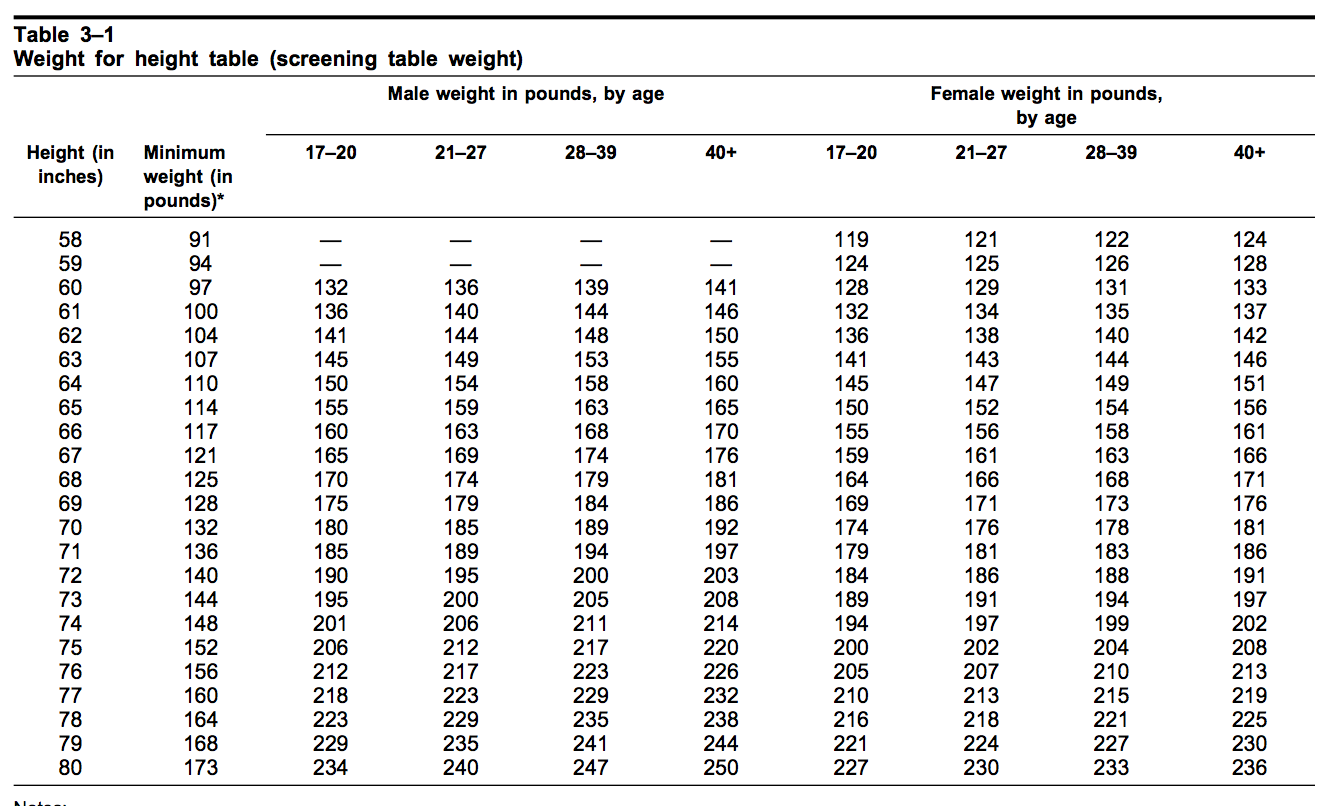The military height and weight chart is an essential tool for those seeking to join the armed forces. Each branch of the military has specific physical requirements that candidates must meet to ensure they are fit for service. Understanding these requirements is crucial, as they can significantly influence the recruitment process. The height and weight standards are designed to maintain a healthy and capable fighting force, ensuring that all service members meet the demands of their roles.
This article delves into the military height and weight chart, examining its significance, the standards set by various branches, and the implications of these standards for potential recruits. Additionally, we will explore frequently asked questions related to the chart, providing clarity on how these requirements affect aspiring military personnel. Whether you are considering a career in the military or simply interested in understanding the parameters of military fitness, this guide is tailored for you.
In the following sections, we will break down the military height and weight chart, answering common queries, and outlining the requirements across different branches. This comprehensive look will help demystify the process and provide you with the necessary information to prepare for a successful military career.
What is the Military Height and Weight Chart?
The military height and weight chart is a set of guidelines used by the armed forces to determine the acceptable height and weight of recruits. It ensures that service members maintain a healthy body composition, which is critical for physical performance in demanding situations. Each branch of the military has its unique standards, which are regularly updated to reflect the evolving nature of military service.
Why is the Military Height and Weight Chart Important?
Maintaining physical fitness is vital in the military for various reasons:
- Operational Readiness: Service members need to be in peak physical condition to handle the rigors of military duties.
- Health and Safety: Adhering to height and weight standards reduces the risk of injury and health issues.
- Team Cohesion: Uniformity in physical standards promotes teamwork and morale among service members.
How is the Military Height and Weight Chart Utilized?
The military height and weight chart is used during the recruitment process, as well as throughout a service member's career. Candidates must meet these standards during initial assessments, and they are regularly evaluated to ensure ongoing compliance. Those who do not meet the requirements may face consequences, including the need for remedial training or, in some cases, separation from service.
What Are the Height and Weight Standards for Each Branch?
Each branch of the military has its specific height and weight standards. Here’s a breakdown of the general requirements:
Army Height and Weight Standards
The U.S. Army utilizes a height and weight chart that varies based on age and gender. The specific standards are as follows:
- Height: Ranges from 58 to 80 inches
- Weight: Varies from 90 to 300 pounds
Navy Height and Weight Standards
The U.S. Navy also has its own criteria:
- Height: Ranges from 60 to 80 inches
- Weight: Varies from 100 to 280 pounds
Air Force Height and Weight Standards
The U.S. Air Force maintains similar standards:
- Height: Ranges from 58 to 80 inches
- Weight: Varies from 110 to 260 pounds
Marine Corps Height and Weight Standards
The U.S. Marine Corps has strict standards that include:
- Height: Ranges from 58 to 78 inches
- Weight: Varies from 100 to 250 pounds
What Happens if You Do Not Meet the Standards?
Failing to meet the military height and weight chart standards can have significant implications:
- Recruits may be disqualified from enlistment.
- Current service members may face additional training or remediation programs.
- In extreme cases, failure to comply can lead to separation from the military.
How to Prepare for the Military Height and Weight Standards?
Preparation is key for those looking to meet the military height and weight chart requirements. Here are some effective strategies:
- Consult a Nutritionist: Professional guidance can help you create a balanced diet plan.
- Engage in Regular Exercise: A mix of cardio and strength training can improve fitness levels.
- Monitor Your Progress: Keep track of your height and weight to ensure you are within the standards.
- Stay Informed: Regularly review the military height and weight chart for updates.
What Resources Are Available for Aspiring Recruits?
A variety of resources can assist aspiring military recruits in meeting the height and weight standards:
- Military Recruitment Offices: They can provide information and guidance on physical requirements.
- Fitness Programs: Many organizations offer training programs tailored to military standards.
- Online Tools: Websites and apps can help track fitness and nutrition.
Conclusion: The Path to Military Fitness
Understanding the military height and weight chart is crucial for anyone considering a career in the armed forces. By familiarizing yourself with the requirements and preparing accordingly, you can enhance your chances of success in recruitment and service. Whether you're aiming to join the Army, Navy, Air Force, or Marine Corps, adhering to the physical standards not only ensures eligibility but also fosters a culture of health and readiness that is essential in military life.
Unraveling The Mystery Of Sawyer Sweeten's Net Worth
Unraveling The Mystery: Is Brian Tyler Cohen Married?
Discovering Jamie Luner: A Journey Through Talent And Tenacity


